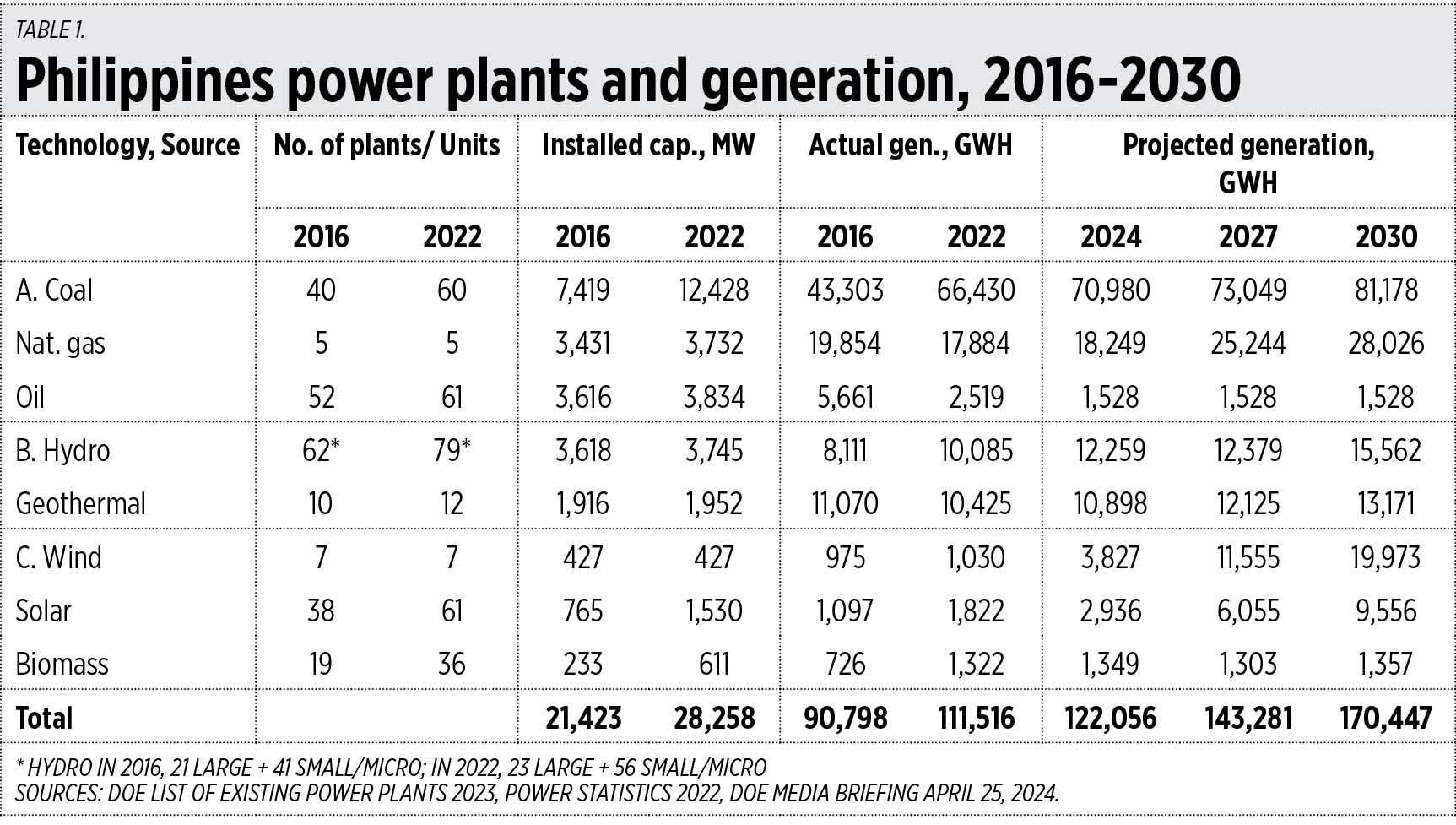
My Cup Of Liberty
By Bienvenido S. Oplas, Jr.
There have been plenty of power deficit incidents recently in the Philippines, with reports on yellow and red alerts starting from April 18 up to May 2. I counted at least 10 stories on this in BusinessWorld alone, including “Visayas under red alert; yellow raised over Luzon” (April 18), “Coal plant moratorium to stay — DoE” (April 26), “Yellow alert raised over Luzon grid” (May 2), and “ERC to suspend WESM trading when Luzon and Visayas are under red alert” (May 2).
Many analyses have been presented explaining why those yellow-red alerts happened. While many assessments are rational, I find others faulty, to say the least. Here are some myths related to the yellow-red alerts:
1. Renewables were not pushed hard enough to replace old, ageing coal and oil plants, leading to the thin power supply.
2. No new power plants went online during the Duterte administration (2016-2022), again leading to the thin power supply.
3. There was a moratorium on the construction of new coal plants from 2020 onwards, ibid.
4. The problem is not in transmission, only in generation.
5. The price control on electricity protects the consumers (bear with me, there is a connection to thin power supplies).
6. El Niño is getting stronger than La Niña, leading to a rising demand for power.
Points one to two are belied by the numbers in Table 1.
One, the number of solar and biomass plants increased during the past administration, from 38 and 19 respectively in 2016, to 61 and 36 in 2022. Over the same period, solar generation doubled while biomass almost tripled. For wind power, the projected generation this year is almost four times the level of 2022, while solar output this year will be nearly double that in 2022.
Two, between 2016 and 2022, 20 new coal plants were added to the grids (see Table 1). In the Luzon grid, the biggest coal power plant addition was GN Power Dinginin with 1,450 megawatts (MW). It became operational in 2021 and 2022. In the Visayas grid, the biggest addition was the coal-powered Therma Visayas, Inc. (TVI) with 338 MW which became operational in 2019. And in the Mindanao grid, the biggest addition was the coal-powered GN Power Kauswagan with 604 MW which became operational in 2019-2020.
 Then we come to the third myth, that there was a moratorium on the construction of coal-powered plants. In the Department of Energy (DoE) website, I came across the “Advisory on the Moratorium of Endorsements for Greenfield Coal-fired Power Projects…” dated Dec. 22, 2020. It said that coal plants are still ALLOWED to be constructed: “… any coal-fired power project in any of the following parameters will not be affected: (a) Committed power projects, (b) Existing power plant complexes which already have firm expansion plans, (c) Indicative power projects with substantial accomplishment… with signed and notarized acquisition of land or Lease Agreement… With approved permits or Resolutions from LGUs…”
Then we come to the third myth, that there was a moratorium on the construction of coal-powered plants. In the Department of Energy (DoE) website, I came across the “Advisory on the Moratorium of Endorsements for Greenfield Coal-fired Power Projects…” dated Dec. 22, 2020. It said that coal plants are still ALLOWED to be constructed: “… any coal-fired power project in any of the following parameters will not be affected: (a) Committed power projects, (b) Existing power plant complexes which already have firm expansion plans, (c) Indicative power projects with substantial accomplishment… with signed and notarized acquisition of land or Lease Agreement… With approved permits or Resolutions from LGUs…”
The DoE’s projections see the continued annual increase in coal generation until 2030 and beyond, but the projected share of coal to the total will decline from 60% in 2022 to 47.6% in 2030 while the share of wind plus solar will increase from 2.5% in 2022 to 17.3% in 2030 (see Table 2).
We then come to the fourth myth, that the problem is not in transmission, only in generation. But when it comes to the grid code requirements for ancillary services, the system operator, the National Grid Corp. of the Philippines (NGCP), has been non-compliant. The NGCP’s franchise was given in 2008 and the firm contracting of reserve requirements was made only after about a decade — but at an insufficient amount. See these stories in relation to this point: “Energy dep’t to require more firm contracts for reserve power” (BusinessWorld, Dec. 25, 2019) and “DoE Pushes NGCP to Contract Sufficient Power Reserves for Energy Reliability” (DoE website, April 24, 2021).
Energy Regulatory Commission Chairperson Monalisa Dimalanta has said that they “penalized the NGCP in November 2022 for not complying with DoE directives on the reserves contracting.
“They paid the penalty and launched the Competitive Selection Process (CSP). They did not get enough offers though so the total contracted capacity is still not at required levels, but the operation of the reserves market allowed NGCP to source that capacity from the market.”
Let us discuss the fifth point: The price control on electricity protects the consumers. I consider the price control via the primary and secondary price cap at the Wholesale Electricity Spot Market (WESM) as anti-consumer. The short-term benefit of a forced lower price is easily negated by an insufficient power supply while demand keeps rising, which leads to even higher price spikes in the medium- to long-term. Also contributing to the situation are the unacted upon supply contracts between generation companies (gencos) and distribution utilities/electric cooperatives, which involve years of waiting for regulatory approvals. Gencos will hesitate to expand their supply capacity if they are in danger of losing money, and the public then suffers via frequent threats of blackout. Keeping prices low therefore leads to yellow and red alerts.
Finally, we come to the sixth point: that El Niño is getting stronger than La Niña, leading to a rising demand for power. The El Niño-La Niña cycle is natural and has been regularly occurring since planet Earth was born some 4.6 billion years ago, so the current El Niño had been predicted to happen after the triple-dip La Niña of 2020-2023, and it is 100% certain that La Niña will happen again — it is projected to appear around July-August this year. Then we prepare for colder temperatures, more rains and floods. This is shown by actual data over the past seven decades (see Figure 1). Demand will rise because of El Niño’s heat (leading to yellow and red alerts because demand is stronger than the supply of electricity), but not because El Niño is getting stronger than La Niña (during which time demand should fall).
To remedy the continuing thin power reserves and frequent yellow-red alerts, the NGCP as system operator be monitored for strict compliance with grid code reserve requirements; price controls at WESM should be removed, and the approval of market-determined power supply contracts should be hastened; we should also hasten the integration of nuclear power in the power system; and, we should ultimately ditch climate alarmism and embrace energy realism, recognizing that the warming-cooling cycle is natural.
Bienvenido S. Oplas, Jr. is the president of Bienvenido S. Oplas, Jr. Research Consultancy Services, and Minimal Government Thinkers. He is an international fellow of the Tholos Foundation.